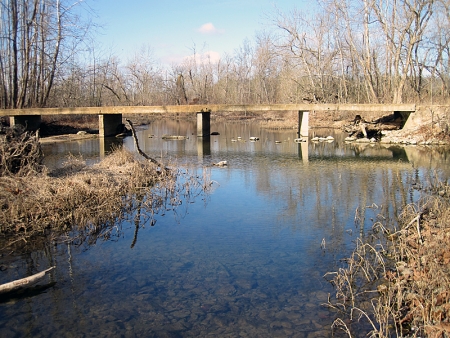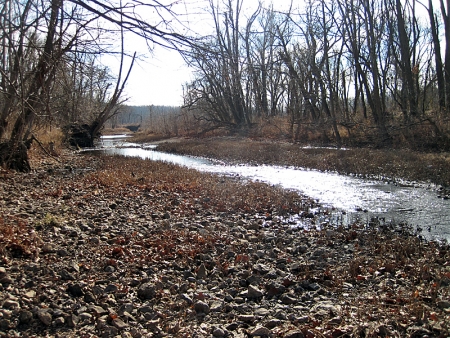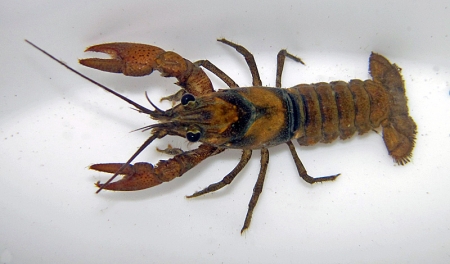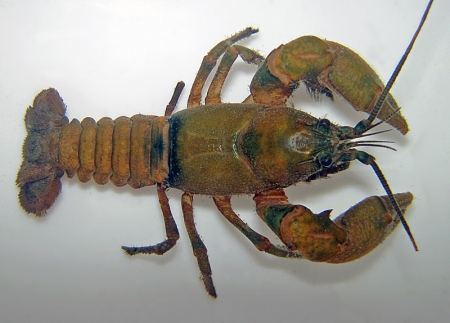The day’s second stop was the MDC’s (Missouri Department of Conservation) George and Vida Martin Access on the Warm Fork of the Spring River to look for Orconects marchandi, the Mammoth Spring Crayfish. O. marchandi is one of the rarest crayfish in Missouri, occurring only in this short stretch of the Warm Fork and the upper Spring River basin in Arkansas, though it’s often the most abundant species in the locations where it does occur (Pflieger, 1996.) In a fairly recent study (Flinders and Magoulick, 2005) O. marchandi was collected from 21 locations, almost entirely small streams in the eastern Spring River drainage. It was found in the Spring River itself at only one location, the confluence of a small stream and was not found in the West Fork and South Fork rivers. It prefers slow moving, shallow water with bottoms of gravel, pebbles and cobble. Intermittent streams had higher population densities than permanent.
Aesthetically, the Warm Fork simply isn’t in the Eleven Point’s class. But then the Eleven Point is a federally designated Wild and Scenic River and the Warm Fork is located on the outskirts of Thayer, surrounded by small farms and pasture land so it’s not really a fair comparison. The large amount of trash littering the area didn’t help.
The Warm Fork doesn’t carry nearly the volume of water as the Eleven Point at Greer, even though both are sixth order streams. Of course the Eleven Point has the added volume of Greer Spring and it’s almost five miles downstream to where the Warm Fork joins with Mammoth Spring to form the Spring River proper.
However, if you want to see O. marchandi in Missouri, this stretch of the Warm Fork is your only option. I don’t know for certain just how far up the Warm Fork O. marchandi occurs, but it’s not present at MDC’s Warm Fork Conservation Area eight miles upstream. The only other public access on this stretch of river is Warm Fork Park right off of US 63 in downtown Thayer. And since I prefer to not have an audience, Martin Access was my choice.
Pflieger states that O. marchandi is found on riffles with rock/cobble substrate (I later found this to not necessarily be the case) so I started my search in the riffle area. The riffle was very shallow (~2”), had small gravel only and I found nothing. There was a shallow pool (the area in the foreground in the first photo) with some nice rocks off to one side and searching here provided immediate results. I quickly found a half dozen O. marchandi along with a couple of Cambarus hubbsi (Hubb’s Crayfish) and a single, small O. punctimanus (Spothanded Crayfish.)
I placed two of the O. marchandi and one of the C. hubbsi in the bucket and started shooting photos. I don’t know what the water temperature was (I really need to add a thermometer to my kit) but after about 40 shots, the shutter on my camera stopped working! Which was just as well because my hands were freezing. Yes, I have gloves, but I can’t manipulate the camera buttons if I have them on.
It was only later, looking at the photos that I realized that the C. hubbsi was missing part of a rear leg and one of the O. marchandi had mismatched pincers. I’m assuming that it was lost during a molt and had not been fully regenerated yet. Both O. marchandi were approximately 1” in length while the C. hubbsi was about twice that.
With both target species found and no other stops planned, it was time to grab a bite to eat and head home. And get some warmth back in my hands!
| References cited: |
| Flinders, C. A., AND D. D. Magoulick. 2005. Distribution, habitat use and life history of stream-dwelling crayfish in the Spring River drainage of Arkansas and Missouri with a focus on the imperiled Mammoth Spring crayfish (Orconectes marchandi). American Midland Naturalist 154:358-374. |
| Pflieger, W.L. 1996. The Crayfishes of Missouri. Missouri Dept. of Conservation, Jefferson City, MO. 152 pp. |




